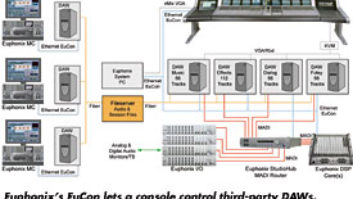Seven years ago, Yamaha unveiled its first full-featured digital console: the 02R. Offering 24 analog inputs and 16 tape returns for a total of 40 inputs, the 20-bit 02R was an instant success. However, production needs have changed since 1995, and today’s requirements for more inputs, 24-bit/96kHz recording and surround mixing have surpassed the 02R’s capabilities.
Over the past year, rumors and speculation have abounded about Yamaha’s next-generation production console — now, it’s finally here. Unveiled at November’s InterBEE 2001 broadcast show in Japan, the Yamaha DM2000 is a 96-input console designed for true 24/96 production. The DM2000 contains the processing power of nine 02Rs, and, thanks to new DSP7 LSI chips with 32-bit (58-bit accumalator) internal processing, no channels are “lost” in 96kHz mode, a significant feature that distinguishes the DM2000 from its competitors.
A major design objective for the DM2000 was ease of use. The console has many single-knob-per-function controls, four soft keys and four rotary controls below the large LCD, and 16 keys for user-defined functions, such as individually muting surround monitors, recalling scene memories, etc. Five “bank” switches offer immediate access to any of the four groups of 24-input channels and the output buses, and the 24 100mm touch-sensitive moving faders immediately reset to the relevant values for the selected bank.
The master section provides full transport control: rwd/ff/stop/play/record keys, a jog/scrub wheel and 24-track arming keys with four arming groups. An auto-locator offers eight memory presets, RTZ and auto-punch with rehearse.
A vacuum fluorescent display above each fader strip shows each channel’s name, a useful reminder when switching between banks. Each channel has dedicated buttons for mute, solo, automation and channel select. Pressing the latter for any channel activates the large, central panel with switches and knobs for setting routing, phase, channel insert, delay, sends, stereo/surround panning (via joystick) and the 4-band parametric EQ. A bright LED on each EQ band indicates gain or frequency settings.
The DM2000 was designed with multichannel production in mind, and includes 5.1-friendly features such as joystick panning, true surround monitoring, bass management, and a downmix matrix that enables LCRS and stereo mix monitoring. Multiple 5.1 stem mixes can be handled easily, and the master section has separate controls for surround and stereo control room volume.
The DM2000 includes numerous 96kHz-compatible stereo effects, many designed for surround mixing. Up to eight internal, 32-bit multi-effects can operate simultaneously; full-function compressor and gating is available on every channel; and six 31-band graphic equalizers are included. Dedicated Effects/Plug-In keys allow fast access to parameters for any of the eight assignable effects.
The MB2000 meter bridge’s 48 12-segment meters can display pre-EQ, pre-fader or post-fader signal levels, or signal levels on the console’s eight buses, 12 aux sends and four stereo matrix buses. Also included are dual high-res, 32-segment meters for the stereo bus and an LED switchable between SMPTE timecode and measures/beats/clocks.
The rear panel has balanced XLR and TRS connectors for all 24 inputs. Two-track I/Os are balanced/unbalanced analog, in addition to AES/EBU and co-ax S/PDIF digital connections. Onboard sample rate conversion and a wide range of sync and control options and standard wordclock I/Os are available. Six mini-YGDAI slots accept various I/O (analog, ADAT, AES/EBU, TDIF) and effects cards, as well as Apogee’s high-performance AD/DA boards and Waves’ Y56k card. Best of all, cascade ports enable two DM2000s to work in tandem for those complex 192-input mixes!
The DM2000 includes extensive support for Digidesign’s Pro Tools. (Support for Steinberg’s Nuendo is under development.) Yamaha’s Studio Manager software (for Mac and PC) ships with the mixer and offers graphical control of all DM2000 parameters via an external computer.
Though the DM2000 has been designed primarily for recording and post-production applications, the system’s relatively small format and comprehensive recall capabilities should also appeal to the live sound and installation markets. A target price of under $20,000 has been set, and deliveries are slated to begin this April. For more information, visit www.yamaha.com/proaudio.



